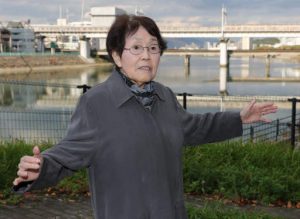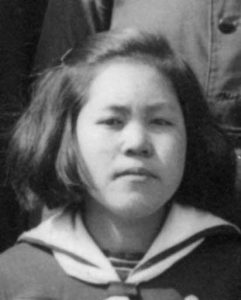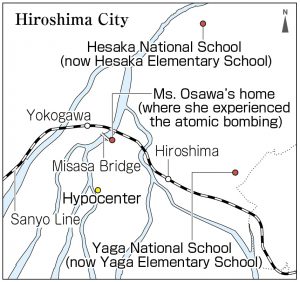Survivors’ Stories: Michiko Osawa, 91, Hiroshima — “German priest saved my life”
Dec. 7, 2020
by Miho Kuwajima, Staff Writer
Late at night on the day of the atomic bombing, Michiko Osawa (née Kikkawa), 91, was buried under a house that had collapsed from the A-bomb’s blast, when Father Klaus Luhmer, a native of Germany, happened to pass by and save her. The atomic bombing took the lives of her mother and sister, but Ms. Osawa was saved miraculously, leading to the births of her grandchildren and great-grandchildren.
She was 15 years old and in her fourth year at Hiroshima First Municipal Girls’ High School (now Funairi High School), but there were no classes being held at that time. Instead, she and her classmates were mobilized to work at a Japan Steel Works factory, located in Nishikaniya-cho (now part of Minami Ward). On August 6, 1945, the factory was closed in an attempt to conserve electricity.
Ms. Osawa, her mother Asayo, her older sister Chizuko, and Chizuko’s husband Kazuo Kodama were chatting after breakfast at their home near Misasa Bridge in Nishihakushima-cho (now part of Naka Ward), when she saw a flash reminiscent of an electrical short-circuit. She was blown off her feet by the A-bomb blast, and their big, two-story house, which stood 1.4 kilometers from the hypocenter, collapsed.
They were pinned by posts that hindered their movement. Mr. Kodama appeared to be dead. “My baby’s not moving,” Ms. Osawa heard as Chizuko’s voice choked with tears. The couple had returned from Tokyo to give birth in Hiroshima. Asayo yelled many times, “Someone help us! My girls are buried underneath here!” but all they heard were people’s footsteps on the roof and earthen walls that covered them. Gradually, she also picked up the crackling sound of burning wood.
It was already midnight, and she was losing consciousness. “Are you here; are you here?” The voice of a non-Japanese man brought her back. Thinking he might be an American soldier, she grew nervous. He was not a soldier, it turned out, and he and other civil defense volunteers went about rescuing her and her family, helping them to lie down on a riverbank. “Most things around the house were burned to the ground. I saw fires flare out from the windows of the Fukuya Department Store,” described Ms. Osawa. As dawn broke, her father and relatives rushed to help and took them to the village of Hesaka (now part of Higashi Ward) by horse-drawn cart.
The faces and flesh of the arms and legs of her mother and sister had been scraped up when they were pulled from the rubble, exposing bare bones. Pus oozed from the wounds. Chizuko gave birth, but the chubby infant was stillborn. They named the dead newborn “Kazuo” (same name as Chizuko’s husband but with one Chinese character different) as proof that he had been born into this world.
After staying at Hesaka National School (now Hesaka Elementary School), which had been turned into a first-aid station, they were moved to Yaga National School (now Yaga Elementary School). Many of the injured at that school died one after another, with the bodies cremated in the schoolyard. Falling into the depths of despair after the loss of her husband and newborn, Chizuko breathed her last on October 23.
Ms. Osawa and her older brother, who was demobilized and returned home from the war, helped support the family by selling peanuts in front of the Fukuya Department Store as a way to survive the postwar period. She married at the age of 24 and was soon blessed with her first daughter Yumi, 66, and second daughter Norimi, 61. Asayo, on the other hand, spent most of her days confined to bed due to leukemia and other illnesses and died in 1956.
Last fall, thanks to an article that appeared in the Chugoku Shimbun prior to the Pope Francis’ visit to Hiroshima, Ms. Osawa learned that the person who had saved her life at the time of the atomic bombing was Father Klaus Luhmer of the Society of Jesus. Father Luhmer had left a diary in which he described his saving a mother and two daughters buried under a collapsed house near Misasa Bridge when on his way to the city from the Nagatsuka Jesuit novitiate in the area of Gion-cho (now part of Asaminami Ward) to assist in the rescue effort.
Ms. Osawa wanted to express her sincere gratitude to the priest by “thanking him for saving us.” But the Jesuit priest had died nine years before that time. Father Luhmer’s diary is currently on permanent display at the Hiroshima Peace Memorial Museum.
Many of her classmates and students in the lower grades of her school perished in the atomic bombing. Ms. Osawa has lived with guilt about surviving the blast when so many had died. “In retrospect, what a cruel thing was done to us. Nuclear weapons kill everyone: both those who drop the weapon and those on whom the weapon is dropped. I believe it’s completely absurd to even possess such weapons,” she stressed.
(Originally published on December 7, 2020)
Learned from news article about person who saved her, her mother, and sister that day from under collapsed house
Late at night on the day of the atomic bombing, Michiko Osawa (née Kikkawa), 91, was buried under a house that had collapsed from the A-bomb’s blast, when Father Klaus Luhmer, a native of Germany, happened to pass by and save her. The atomic bombing took the lives of her mother and sister, but Ms. Osawa was saved miraculously, leading to the births of her grandchildren and great-grandchildren.
She was 15 years old and in her fourth year at Hiroshima First Municipal Girls’ High School (now Funairi High School), but there were no classes being held at that time. Instead, she and her classmates were mobilized to work at a Japan Steel Works factory, located in Nishikaniya-cho (now part of Minami Ward). On August 6, 1945, the factory was closed in an attempt to conserve electricity.
Ms. Osawa, her mother Asayo, her older sister Chizuko, and Chizuko’s husband Kazuo Kodama were chatting after breakfast at their home near Misasa Bridge in Nishihakushima-cho (now part of Naka Ward), when she saw a flash reminiscent of an electrical short-circuit. She was blown off her feet by the A-bomb blast, and their big, two-story house, which stood 1.4 kilometers from the hypocenter, collapsed.
They were pinned by posts that hindered their movement. Mr. Kodama appeared to be dead. “My baby’s not moving,” Ms. Osawa heard as Chizuko’s voice choked with tears. The couple had returned from Tokyo to give birth in Hiroshima. Asayo yelled many times, “Someone help us! My girls are buried underneath here!” but all they heard were people’s footsteps on the roof and earthen walls that covered them. Gradually, she also picked up the crackling sound of burning wood.
It was already midnight, and she was losing consciousness. “Are you here; are you here?” The voice of a non-Japanese man brought her back. Thinking he might be an American soldier, she grew nervous. He was not a soldier, it turned out, and he and other civil defense volunteers went about rescuing her and her family, helping them to lie down on a riverbank. “Most things around the house were burned to the ground. I saw fires flare out from the windows of the Fukuya Department Store,” described Ms. Osawa. As dawn broke, her father and relatives rushed to help and took them to the village of Hesaka (now part of Higashi Ward) by horse-drawn cart.
The faces and flesh of the arms and legs of her mother and sister had been scraped up when they were pulled from the rubble, exposing bare bones. Pus oozed from the wounds. Chizuko gave birth, but the chubby infant was stillborn. They named the dead newborn “Kazuo” (same name as Chizuko’s husband but with one Chinese character different) as proof that he had been born into this world.
After staying at Hesaka National School (now Hesaka Elementary School), which had been turned into a first-aid station, they were moved to Yaga National School (now Yaga Elementary School). Many of the injured at that school died one after another, with the bodies cremated in the schoolyard. Falling into the depths of despair after the loss of her husband and newborn, Chizuko breathed her last on October 23.
Ms. Osawa and her older brother, who was demobilized and returned home from the war, helped support the family by selling peanuts in front of the Fukuya Department Store as a way to survive the postwar period. She married at the age of 24 and was soon blessed with her first daughter Yumi, 66, and second daughter Norimi, 61. Asayo, on the other hand, spent most of her days confined to bed due to leukemia and other illnesses and died in 1956.
Last fall, thanks to an article that appeared in the Chugoku Shimbun prior to the Pope Francis’ visit to Hiroshima, Ms. Osawa learned that the person who had saved her life at the time of the atomic bombing was Father Klaus Luhmer of the Society of Jesus. Father Luhmer had left a diary in which he described his saving a mother and two daughters buried under a collapsed house near Misasa Bridge when on his way to the city from the Nagatsuka Jesuit novitiate in the area of Gion-cho (now part of Asaminami Ward) to assist in the rescue effort.
Ms. Osawa wanted to express her sincere gratitude to the priest by “thanking him for saving us.” But the Jesuit priest had died nine years before that time. Father Luhmer’s diary is currently on permanent display at the Hiroshima Peace Memorial Museum.
Many of her classmates and students in the lower grades of her school perished in the atomic bombing. Ms. Osawa has lived with guilt about surviving the blast when so many had died. “In retrospect, what a cruel thing was done to us. Nuclear weapons kill everyone: both those who drop the weapon and those on whom the weapon is dropped. I believe it’s completely absurd to even possess such weapons,” she stressed.
(Originally published on December 7, 2020)










